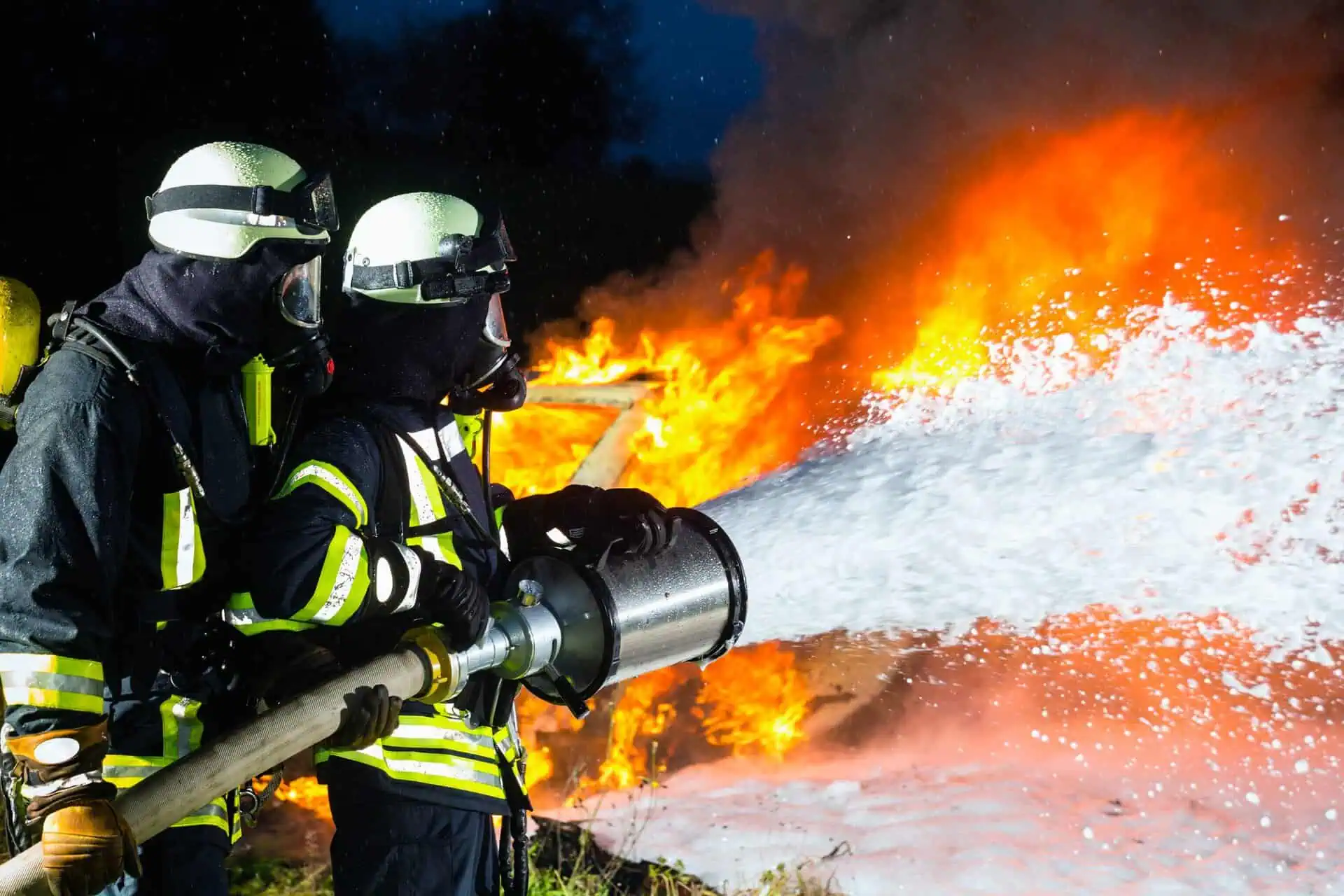AFFF Endometrial Cancer Lawsuit
- Last Updated: June 12th, 2025

Attorney Jessica Paluch-Hoerman, founder of TruLaw, has over 28 years of experience as a personal injury and mass tort attorney, and previously worked as an international tax attorney at Deloitte. Jessie collaborates with attorneys nationwide — enabling her to share reliable, up-to-date legal information with our readers.
Legally Reviewed
This article has been written and reviewed for legal accuracy and clarity by the team of writers and legal experts at TruLaw and is as accurate as possible. This content should not be taken as legal advice from an attorney. If you would like to learn more about our owner and experienced injury lawyer, Jessie Paluch, you can do so here.
Fact-Checked
TruLaw does everything possible to make sure the information in this article is up to date and accurate. If you need specific legal advice about your case, contact us by using the chat on the bottom of this page. This article should not be taken as advice from an attorney.
Key takeaways:
- Victims of endometrial cancer who have been exposed to AFFF firefighting foam are filing lawsuits against manufacturers, alleging they hid knowledge of the toxic dangers.
- Legal experts in environmental and personal injury law are helping those affected file claims for compensation covering medical costs, suffering, and lost wages due to illness from AFFF exposure.
- PFAS chemicals found in AFFF have been linked to health issues, including hormone disruption and cellular damage, increasing the risk of endometrial cancer, especially in women.
Overview of the AFFF Endometrial Cancer Lawsuit
On this page, we’ll discuss an overview of the AFFF Endometrial Cancer Lawsuit, potential AFFF lawsuit settlement amounts, who qualifies to file an AFFF lawsuit, and much more.
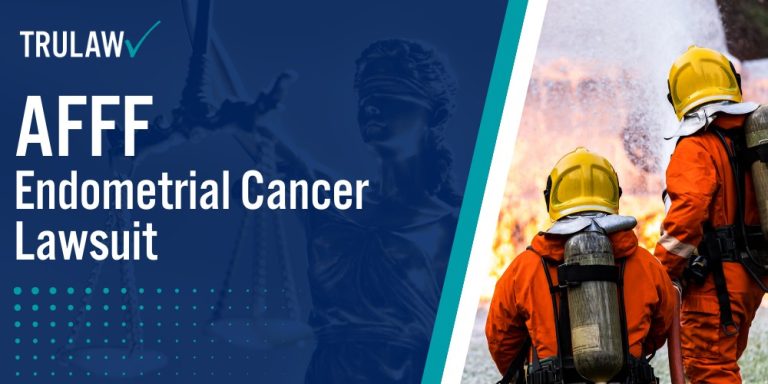
Intro to the AFFF Endometrial Cancer Lawsuits
Aqueous Film-Forming Foam (AFFF) was developed in the 1960s by the US Navy and 3M to combat fires involving flammable liquids.
The foam contains PFAS chemicals, often referred to as “forever chemicals,” due to their persistence in the environment and the human body.
PFAS chemicals in AFFF have properties that make them effective in firefighting, such as their ability to repel oil and water.
However, exposure to these chemicals has been linked to serious health risks, including various forms of cancer (such as endometrial cancer).
Lawsuits are currently being filed against AFFF manufacturers for allegedly failing to warn about the dangers associated with these toxic chemicals.
Individuals who have suffered from health problems potentially caused by AFFF exposure are pursuing legal claims.
If you or a loved one has been diagnosed with endometrial cancer, another type of cancer, or related health issues, you may qualify to file an AFFF Firefighting Foam Lawsuit.
You can use the chat on this page to instantly see if you may qualify to file an AFFF lawsuit.
The AFFF firefighting foam lawyers at TruLaw and our partner law firms are supporting individuals who believe they were harmed by AFFF exposure.
Should you have any questions about the claims process or the AFFF multidistrict litigation (MDL), don’t hesitate to reach out.
We’re here to help guide you through the next steps.
Table of Contents
The Link Between AFFF Firefighting Foam and Endometrial Cancer Risk
Endometrial cancer is a common form of uterine cancer that begins in the lining of the uterus, known as the endometrium.
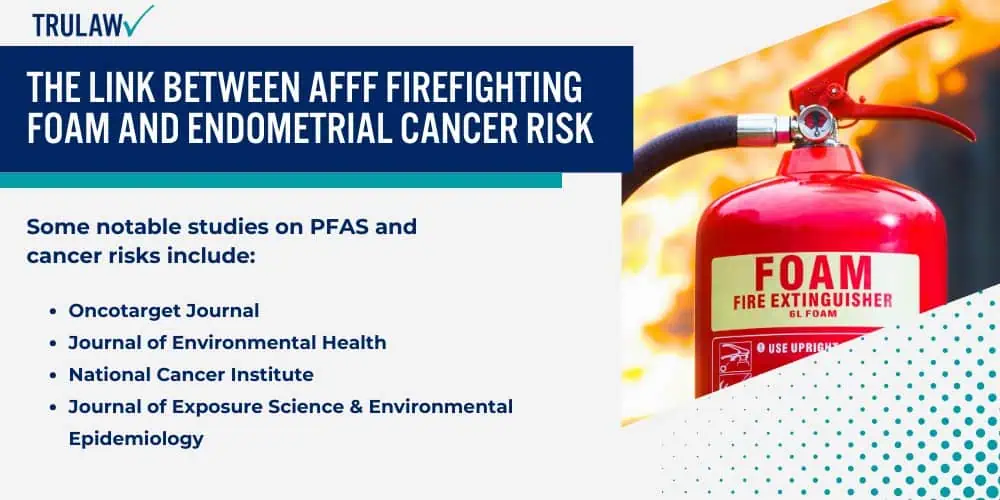
It most frequently affects women over the age of fifty (50).
The endometrial lining undergoes cyclical changes, thickening and shedding during the menstrual cycle.
However, if abnormal cells within this tissue begin to grow uncontrollably, they may form tumors, which can be cancerous.
The most prevalent form of endometrial cancer is endometrioid adenocarcinoma, though there are several subtypes.
While the exact cause of endometrial cancer remains uncertain, risk factors such as hormonal imbalances and genetic predispositions are known contributors.
Another potential risk factor under investigation is exposure to PFAS chemicals, found in products like AFFF firefighting foam.
PFAS Exposure and Its Association with Endometrial Cancer
Several studies have explored the relationship between PFAS exposure and the risk of developing endometrial cancer.
Research suggests that PFAS chemicals, commonly referred to as “forever chemicals,” may contribute to an increased risk of this disease.
Some notable studies on PFAS and cancer risks include:
- Journal of Exposure Science & Environmental Epidemiology: This study from the Journal of Exposure Science & Environmental Epidemiology examines phenols, parabens, and PFAS in participants with cancer diagnoses.
- Oncotarget Journal: This study from the Oncotarget Journal discusses how perfluorooctanoic acid (PFOA) may promote cancer cell migration and invasion in endometrial cancer.
- Journal of Environmental Health: This study from the Journal of Environmental Health analyzes the impact of PFAS on cancer prognosis in melanoma patients.
- National Cancer Institute: This study from the National Cancer Institute focuses on the connection between circulating PFAS and gynecological cancers, including endometrial cancer.
How Endometrial Cancer is Detected
Early detection is important to the successful treatment of endometrial cancer.
Regular medical evaluations can help identify cancer in its initial stages when treatment is most effective.
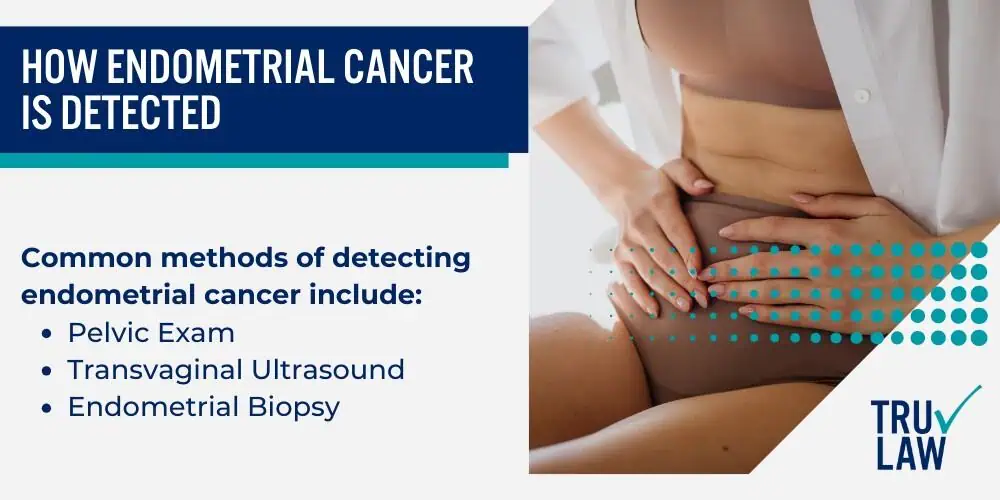
Common methods of detecting endometrial cancer include:
- Pelvic Exam: A healthcare provider performs a physical exam to check for any abnormalities in the pelvic region.
- Transvaginal Ultrasound: This imaging technique creates a visual of the uterus, allowing healthcare professionals to detect any abnormalities.
- Endometrial Biopsy: A sample of tissue is taken from the endometrium and examined for cancer cells.
Treatment Options for Endometrial Cancer
Treatment for endometrial cancer is based on factors such as the stage of the cancer and the patient’s health.
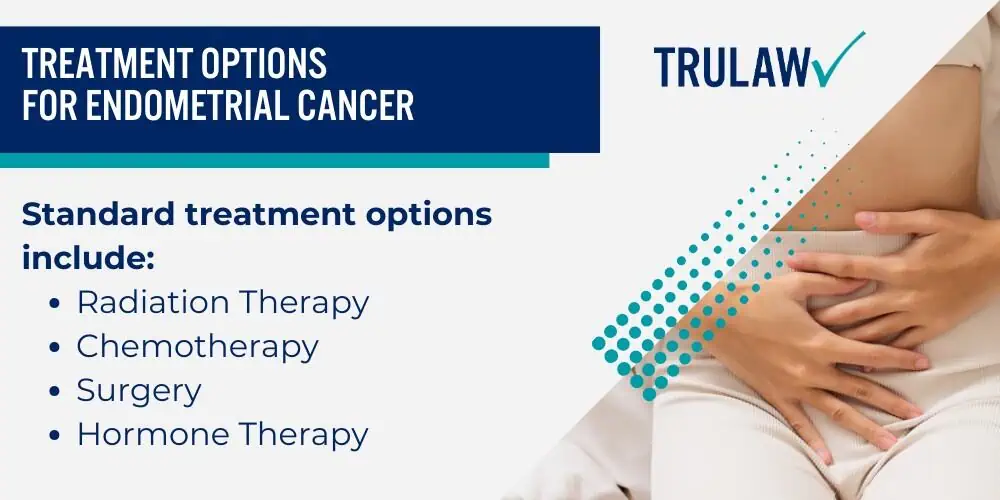
Standard treatment options include:
- Radiation Therapy: High-energy rays are used to destroy cancer cells, either before or after surgery, or as a standalone treatment in some cases.
- Chemotherapy: This involves the use of drugs to kill or slow the growth of cancer cells, often used for advanced stages or recurrent cancer.
- Surgery: A hysterectomy, or removal of the uterus, is the most common treatment for early-stage cancer. In some cases, lymph nodes may also be removed.
- Hormone Therapy: In certain cases, hormone therapy may be used to block estrogen, which can promote the growth of cancer cells.
The prognosis for endometrial cancer can vary depending on the stage of diagnosis and other factors.
Early detection and appropriate treatment can greatly improve outcomes for those affected by this disease.
PFAS Chemicals in Firefighting Foam and Their Impact on Human Health
For decades, both chemical manufacturers and the U.S. Navy, who first approved the use of AFFF firefighting foam, were aware of its potential toxicity.
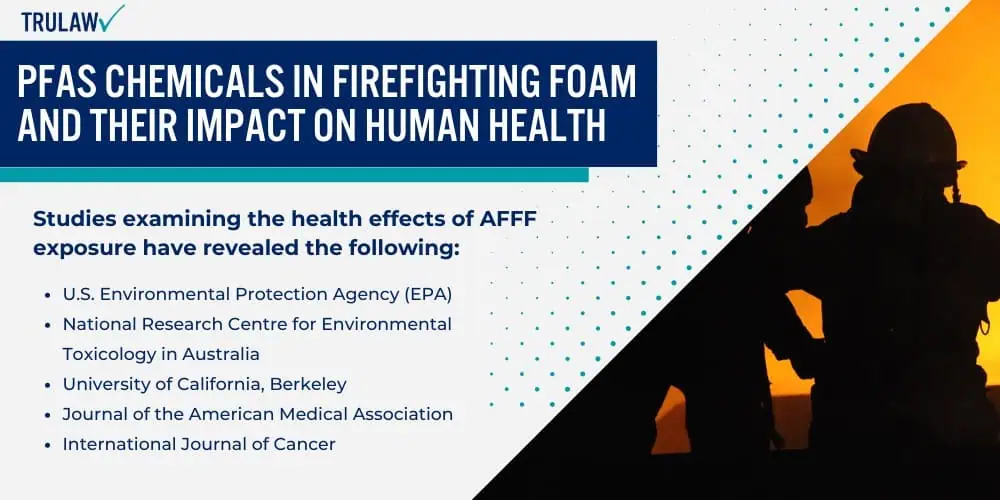
Despite this knowledge, it wasn’t until pressure from the Environmental Protection Agency (EPA) that the U.S. Department of Defense issued an official warning, acknowledging the consequential health and environmental risks posed by the chemicals in AFFF.
Research studies have since linked Per- and Polyfluoroalkyl Substances (PFAS), found in firefighting foam, to serious health concerns, including various forms of cancer.
These chemicals have widespread impacts due to their persistence in the environment and ability to accumulate in the human body.
Studies examining the health effects of AFFF exposure have revealed the following:
- The U.S. Environmental Protection Agency (EPA) has issued a health advisory, warning that long-term exposure to PFOA and PFOS above certain levels could harm human health. As a result, in 2024, the EPA announced the National Primary Drinking Water Regulation (NPDWR) for six (6) PFAS chemicals — establishing legally enforceable Maximum Contaminant Levels (MCLs) that water systems must test and confirm are met before distributing drinking water to the public.
- Research conducted by the National Research Centre for Environmental Toxicology in Australia found that firefighters were more likely to have elevated levels of fluorinated surfactants in their bloodstream.
- A study from the University of California, Berkeley discovered that female firefighters who had used firefighting foam within the last year had higher concentrations of several PFAS chemicals in their bodies compared to those who had not.
- A study published in the Journal of the American Medical Association demonstrated a statistical connection between PFOA exposure and increased risks of kidney cancer, testicular cancer, and ulcerative colitis.
- The International Journal of Cancer published a study linking PFOS exposure to a higher risk of breast cancer.
- The International Agency for Research on Cancer (IARC) has classified PFOA as carcinogenic to humans (Group 1) and classified PFOS as possibly carcinogenic to humans (Group 2B).
These studies underscore the potential dangers of AFFF exposure and the need for individuals to explore their legal options if they have been affected.
Overview of AFFF Firefighting Foam Lawsuits
Aqueous Film-Forming Foam (AFFF) became widely used in firefighting due to its exceptional ability to resist grease, water, and heat, making it highly effective in extinguishing certain types of fires.
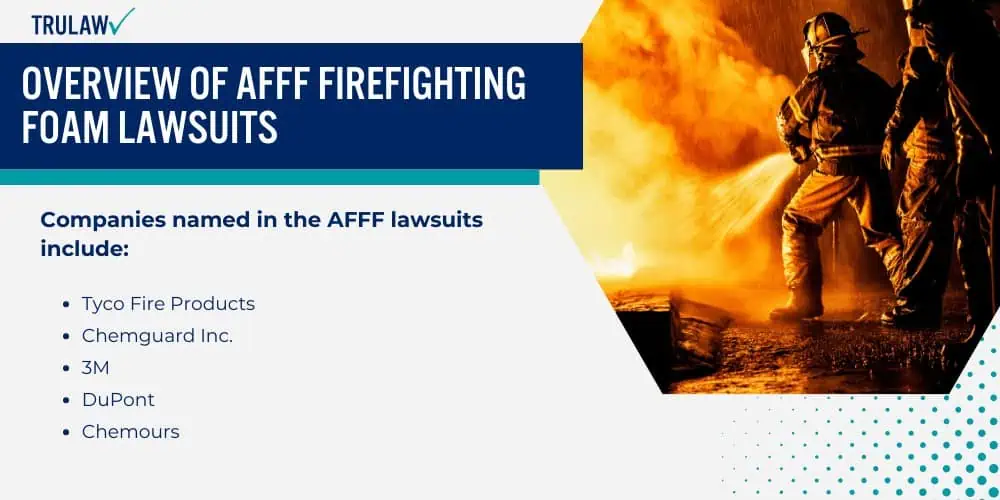
However, AFFF contains harmful levels of poly-fluoroalkyl substances (PFAS), also known as “forever chemicals” because they do not naturally break down in the environment or the human body.
Exposure to these toxic chemicals has been linked to serious health conditions, including various forms of cancer.
Lawsuits are being filed against AFFF manufacturers for failing to warn people about the potential health risks associated with these dangerous firefighting foams.
Many of these AFFF lawsuits are being consolidated into a multidistrict litigation (MDL), which helps streamline the legal process and ensures consistent rulings in related cases.
If you or someone you love was exposed to AFFF and developed cancer or other health complications, you may be eligible to pursue legal action.
You can use the chat on this page to instantly find out if you qualify to file an AFFF lawsuit.
Who Are the Defendants in AFFF Firefighting Foam Cases?
AFFF cancer lawsuits are being filed against the manufacturers and distributors of these toxic firefighting foams.
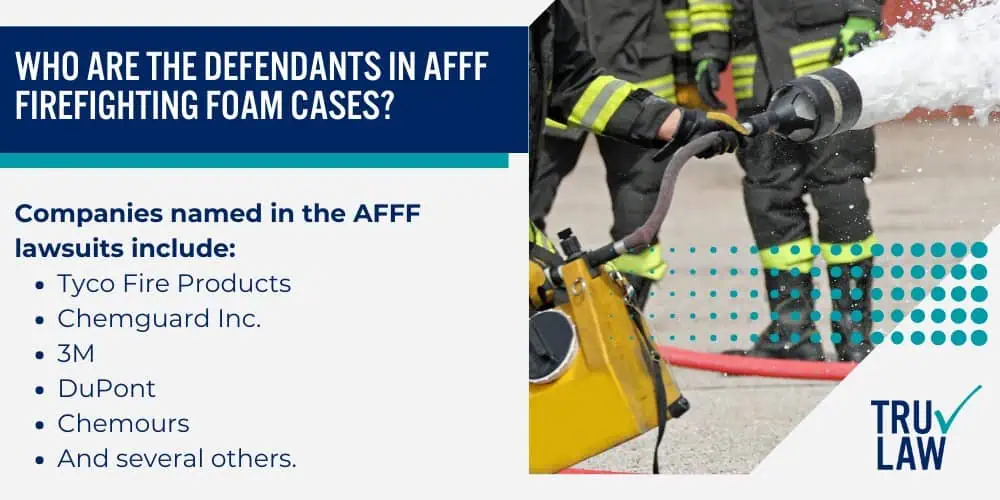
Companies named in the AFFF lawsuits include:
- Tyco Fire Products
- Chemguard Inc.
- 3M
- DuPont
- Chemours
- And several others.
What Are the Average Settlement Amounts in Firefighting Foam Lawsuits?
Currently, no settlements have been reached in the AFFF litigation.
However, some legal experts estimate that AFFF lawsuit settlements could range from $20,000 to $600,000 (or more), depending on the specifics of each case.
These figures are merely projections based on similar mass tort cases and prior settlements for cancer diagnoses.
There is no guarantee of financial compensation in these lawsuits, and each case’s outcome depends on various individual factors.
For more information about your potential case and possible settlement expectations, reach out to our team at TruLaw.
To do so, you can use the chat on this page for an instant case evaluation and quickly find out if you may be eligible to file an AFFF lawsuit.
How to File an AFFF Endometrial Cancer Lawsuit
We understand that filing an AFFF firefighting foam cancer lawsuit can feel overwhelming, especially for individuals dealing with health complications linked to AFFF foam exposure.
Occupational exposure to AFFF has been associated with various types of cancer, including endometrial cancer, and other serious health conditions.
If you or a loved one has experienced health issues related to toxic firefighting foam exposure, you may qualify to file an AFFF cancer lawsuit.
You can use the chat on this page to instantly determine whether you may be eligible to file an AFFF lawsuit.
The AFFF firefighting foam lawyers at TruLaw and our partner law firms are well-versed in guiding clients through the legal process, helping them gather helpful evidence, and assess potential damages.
Collecting Evidence for AFFF Lawsuits
Gathering strong evidence is a very important step in AFFF lawsuits.
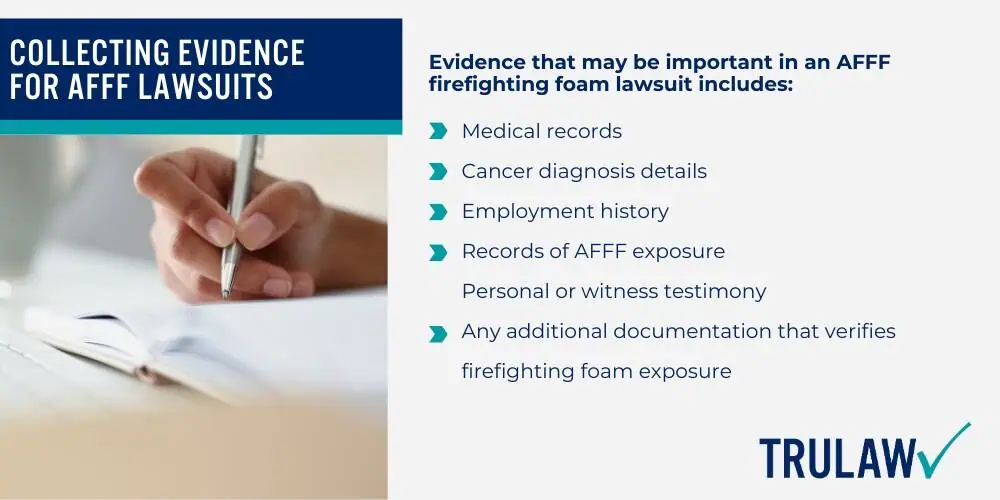
Evidence that may be important in an AFFF firefighting foam lawsuit includes:
- Medical records
- Cancer diagnosis details
- Employment history
- Records of AFFF exposure
- Personal or witness testimony
- Any additional documentation that verifies firefighting foam exposure
Compensation for Damages in Firefighting Foam Lawsuits
Damages refer to the total losses, both economic and non-economic, suffered due to exposure to PFAS-containing firefighting foam products.
The experienced firefighting foam lawyers at TruLaw and our partner law firms help clients assess and calculate these damages — advocating for compensation that accurately reflects the impact on their lives.
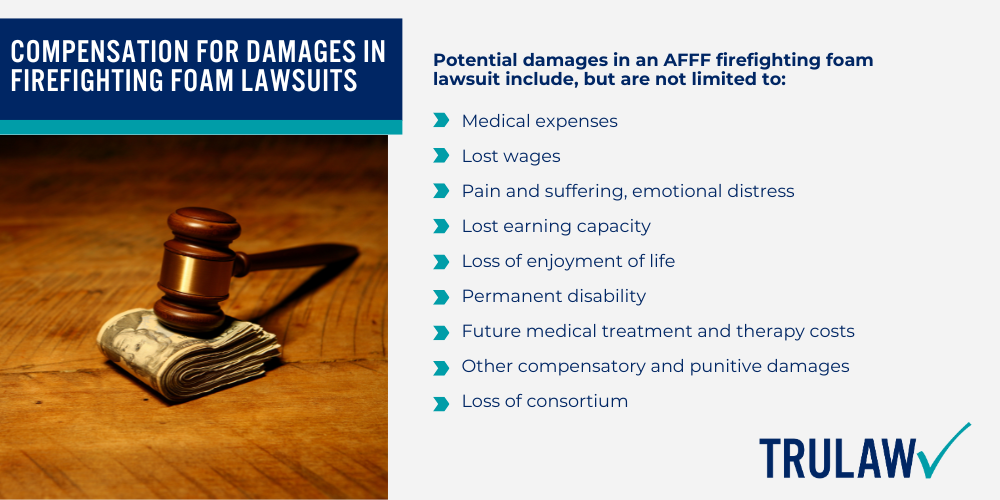
Potential damages in an AFFF firefighting foam lawsuit include, but are not limited to:
- Medical expenses
- Lost wages
- Pain and suffering, emotional distress
- Lost earning capacity
- Loss of enjoyment of life
- Permanent disability
- Future medical treatment and therapy costs
- Other compensatory and punitive damages
- Loss of consortium
Importance of Hiring Experienced Firefighting Foam Attorneys for Your Claim
Typically, an AFFF lawsuit requires specialized knowledge of product liability, toxic tort law, and the challenges of proving a link between AFFF exposure and cancer.
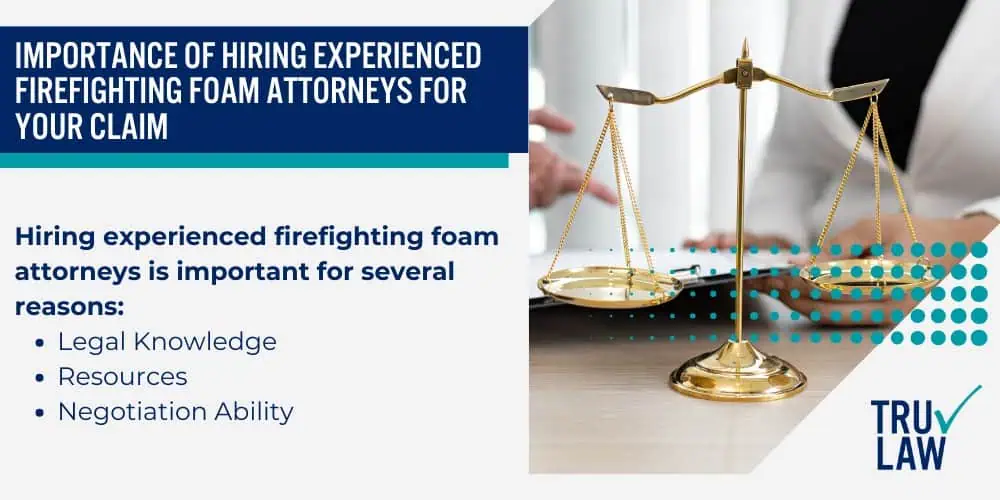
Hiring experienced firefighting foam attorneys is important for several reasons:
- Legal Knowledge: Attorneys who understand AFFF cases can build a compelling argument supported by evidence.
- Resources: Skilled law firms have the necessary resources to conduct thorough investigations and secure expert testimony.
- Negotiation Ability: Attorneys can negotiate with manufacturers and insurers to seek a fair settlement.
Working with knowledgeable attorneys helps ensure that those affected by AFFF exposure can pursue justice and fair compensation for their suffering.
TruLaw: Your Firefighting Foam Cancer Law Firm
The experienced firefighting foam lawyers at TruLaw and our partner law firms are assisting individuals across all fifty (50) states in pursuing claims against firefighting foam manufacturers for the potential health risks associated with AFFF exposure.
TruLaw is committed to helping hold large corporations and chemical manufacturers accountable for the harm caused by AFFF.
Firefighters and others regularly exposed to AFFF deserve the opportunity to pursue justice and compensation for the harm they’ve suffered.
Filing an AFFF lawsuit can be a vital step toward achieving resolution for victims.
AFFF Claims for Endometrial Cancer, Kidney Cancer, & More
Potential claims for AFFF foam lawsuits are being assessed for individuals who were exposed to AFFF firefighting foam and have developed various cancers, including but not limited to:
- Bladder cancer
- Breast cancer
- Colorectal cancer
- Endometrial cancer
- Kidney cancer
- Leukemia
- Liver cancer
- Lymphoma
- Mesothelioma
- Multiple Myeloma
- Non-Hodgkin Lymphoma
- Ovarian cancer
- Pancreatic cancer
- Prostate cancer
- Testicular cancer
- Thyroid cancer
If you or a loved one have been diagnosed with cancer or experienced other health issues after consistent exposure to firefighting foam, you may be eligible to pursue an AFFF lawsuit and seek financial recovery.
You can use the chat on this page for an instant case evaluation and quickly determine if you are eligible to file and AFFF firefighting foam lawsuit.
If you have questions or need assistance with an AFFF claim, don’t hesitate to contact us.
We’re here to help guide you through the process.
AFFF Lawsuit Frequently Asked Questions
-
Do I qualify to file an AFFF lawsuit?
If you were exposed to firefighting foam and developed cancer or other health conditions afterward, you may be eligible to file an AFFF lawsuit.
Plaintiffs in AFFF lawsuits generally allege that manufacturers failed to adequately warn users about the health risks of exposure to PFAS chemicals found in firefighting foam.
These lawsuits are being filed by civilian, airport, and military firefighters, along with military service members exposed during training exercises, workers involved in transporting or disposing of the foam, and others.
Use the chat on this page for an instant case evaluation to determine if you qualify to file an AFFF lawsuit today.
-
What is the average AFFF lawsuit settlement amount?
No settlements have been reached yet in the ongoing AFFF litigation.
However, AFFF attorneys estimate that potential AFFF settlement amounts could range between $20,000 and $600,000 (or more), depending on the strength of the case and other individual factors.
These numbers are not guarantees, but projections based on past mass tort cases involving similar cancer diagnoses and hazardous substances.
For a clearer understanding of what you may expect in your case, use the chat on this page for an instant case evaluation — our team can assist you from there.
-
Is there an AFFF class action lawsuit?
No, there is not an AFFF class action lawsuit for individuals exposed to firefighting foam.
Current AFFF lawsuits are being consolidated into the AFFF firefighting foam multidistrict litigation (MDL).
MDL is a federal legal process designed to streamline these AFFF lawsuits involving similar claims.
Cases related to AFFF exposure are being consolidated in the US District Court for the District of South Carolina.
In an MDL, each plaintiff’s case is handled individually, and any settlements will reflect the specifics of their claim.
This differs from a class action, where compensation is typically divided equally among all plaintiffs, regardless of individual circumstances.
Some law firms incorrectly refer to the AFFF MDL as a “class action,” but this is not accurate.
-
What are the toxic chemicals in AFFF?
Aqueous film-forming foam (AFFF) contains several chemicals, including per- and polyfluoroalkyl substances (PFAS), which are known for their oil- and water-repellent properties.
PFAS are a group of synthetic chemicals used in various products, including firefighting foam.
Two specific PFAS compounds found in AFFF — perfluorooctanoic acid (PFOA) and perfluorooctane sulfonate (PFOS) — have been linked to potential health risks, including a possible association with certain cancers.
These risks have led to growing concerns about the safety of AFFF and its long-term impact on health and the environment.

Managing Attorney & Owner
With over 25 years of legal experience, Jessica Paluch-Hoerman is an Illinois lawyer, a CPA, and a mother of three. She spent the first decade of her career working as an international tax attorney at Deloitte.
In 2009, Jessie co-founded her own law firm with her husband – which has scaled to over 30 employees since its conception.
In 2016, Jessie founded TruLaw, which allows her to collaborate with attorneys and legal experts across the United States on a daily basis. This hypervaluable network of experts is what enables her to share the most reliable, accurate, and up-to-date legal information with our readers!
Additional AFFF Lawsuit resources on our website:
Here, at TruLaw, we’re committed to helping victims get the justice they deserve.
Alongside our partner law firms, we have successfully collected over $3 Billion in verdicts and settlements on behalf of injured individuals.
Would you like our help?
At TruLaw, we fiercely combat corporations that endanger individuals’ well-being. If you’ve suffered injuries and believe these well-funded entities should be held accountable, we’re here for you.
With TruLaw, you gain access to successful and seasoned lawyers who maximize your chances of success. Our lawyers invest in you—they do not receive a dime until your lawsuit reaches a successful resolution!
AFFF Lawsuit claims are being filed against manufacturers of aqueous film-forming foam (AFFF), commonly used in firefighting.
Claims allege that companies such as 3M, DuPont, and Tyco Fire Products failed to adequately warn users about the potential dangers of AFFF exposure — including increased risks of various cancers and diseases.
Depo Provera Lawsuit claims are being filed by individuals who allege they developed meningioma (a type of brain tumor) after receiving Depo-Provera birth control injections.
A 2024 study found that women using Depo-Provera for at least 1 year are five times more likely to develop meningioma brain tumors compared to those not using the drug.
Suboxone Tooth Decay Lawsuit claims are being filed against Indivior, the manufacturer of Suboxone, a medication used to treat opioid addiction.
Claims allege that Indivior failed to adequately warn users about the potential dangers of severe tooth decay and dental injuries associated with Suboxone’s sublingual film version.
Social Media Harm Lawsuits are being filed against social media companies for allegedly causing mental health issues in children and teens.
Claims allege that companies like Meta, Google, ByteDance, and Snap designed addictive platforms that led to anxiety, depression, and other mental health issues without adequately warning users or parents.
Transvaginal Mesh Lawsuits are being filed against manufacturers of transvaginal mesh products used to treat pelvic organ prolapse (POP) and stress urinary incontinence (SUI).
Claims allege that companies like Ethicon, C.R. Bard, and Boston Scientific failed to adequately warn about potential dangers — including erosion, pain, and infection.
Bair Hugger Warming Blanket Lawsuits involve claims against 3M — alleging their surgical warming blankets caused severe infections and complications (particularly in hip and knee replacement surgeries).
Plaintiffs claim 3M failed to warn about potential risks — despite knowing about increased risk of deep joint infections since 2011.
Baby Formula NEC Lawsuit claims are being filed against manufacturers of cow’s milk-based baby formula products.
Claims allege that companies like Abbott Laboratories (Similac) and Mead Johnson & Company (Enfamil) failed to warn about the increased risk of necrotizing enterocolitis (NEC) in premature infants.
Here, at TruLaw, we’re committed to helping victims get the justice they deserve.
Alongside our partner law firms, we have successfully collected over $3 Billion in verdicts and settlements on behalf of injured individuals.
Would you like our help?
